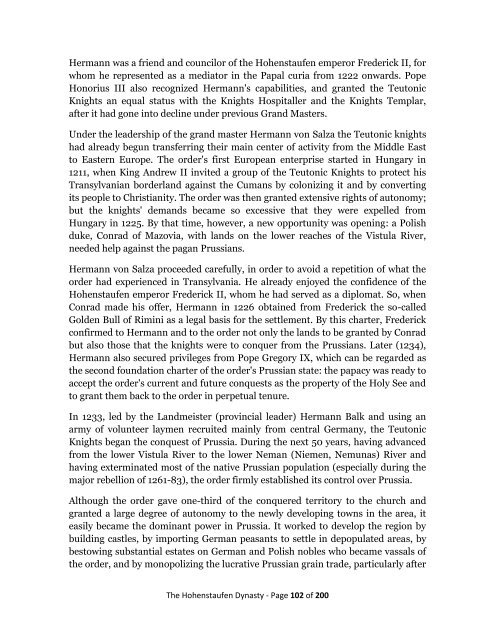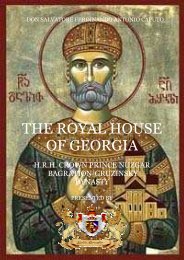here - Nobility Associations
here - Nobility Associations
here - Nobility Associations
You also want an ePaper? Increase the reach of your titles
YUMPU automatically turns print PDFs into web optimized ePapers that Google loves.
Hermann was a friend and councilor of the Hohenstaufen emperor Frederick II, for<br />
whom he represented as a mediator in the Papal curia from 1222 onwards. Pope<br />
Honorius III also recognized Hermann's capabilities, and granted the Teutonic<br />
Knights an equal status with the Knights Hospitaller and the Knights Templar,<br />
after it had gone into decline under previous Grand Masters.<br />
Under the leadership of the grand master Hermann von Salza the Teutonic knights<br />
had already begun transferring their main center of activity from the Middle East<br />
to Eastern Europe. The order's first European enterprise started in Hungary in<br />
1211, when King Andrew II invited a group of the Teutonic Knights to protect his<br />
Transylvanian borderland against the Cumans by colonizing it and by converting<br />
its people to Christianity. The order was then granted extensive rights of autonomy;<br />
but the knights' demands became so excessive that they were expelled from<br />
Hungary in 1225. By that time, however, a new opportunity was opening: a Polish<br />
duke, Conrad of Mazovia, with lands on the lower reaches of the Vistula River,<br />
needed help against the pagan Prussians.<br />
Hermann von Salza proceeded carefully, in order to avoid a repetition of what the<br />
order had experienced in Transylvania. He already enjoyed the confidence of the<br />
Hohenstaufen emperor Frederick II, whom he had served as a diplomat. So, when<br />
Conrad made his offer, Hermann in 1226 obtained from Frederick the so-called<br />
Golden Bull of Rimini as a legal basis for the settlement. By this charter, Frederick<br />
confirmed to Hermann and to the order not only the lands to be granted by Conrad<br />
but also those that the knights were to conquer from the Prussians. Later (1234),<br />
Hermann also secured privileges from Pope Gregory IX, which can be regarded as<br />
the second foundation charter of the order's Prussian state: the papacy was ready to<br />
accept the order's current and future conquests as the property of the Holy See and<br />
to grant them back to the order in perpetual tenure.<br />
In 1233, led by the Landmeister (provincial leader) Hermann Balk and using an<br />
army of volunteer laymen recruited mainly from central Germany, the Teutonic<br />
Knights began the conquest of Prussia. During the next 50 years, having advanced<br />
from the lower Vistula River to the lower Neman (Niemen, Nemunas) River and<br />
having exterminated most of the native Prussian population (especially during the<br />
major rebellion of 1261-83), the order firmly established its control over Prussia.<br />
Although the order gave one-third of the conquered territory to the church and<br />
granted a large degree of autonomy to the newly developing towns in the area, it<br />
easily became the dominant power in Prussia. It worked to develop the region by<br />
building castles, by importing German peasants to settle in depopulated areas, by<br />
bestowing substantial estates on German and Polish nobles who became vassals of<br />
the order, and by monopolizing the lucrative Prussian grain trade, particularly after<br />
The Hohenstaufen Dynasty - Page 102 of 200



